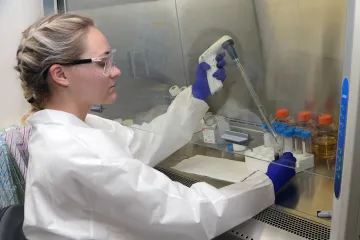Today on National Agriculture Day, the Science and Technology Directorate (S&T) recognizes the importance of agriculture to our communities and our national security.
Here at S&T, we believe that dedicated research and development are critical to ensuring that our domestic agriculture systems are resilient against disturbances that could cause food shortages, sickness or injuries, and economic crises.
These systems and the food they provide are the backbone of the American way of life, our industrious spirit, and our collective health and safety.
In honor of National Agriculture Day and Week, I’d like to spotlight several efforts underway within the Department of Homeland Security’s Centers of Excellence (COE) and S&T’s National Laboratories that focus on preventing livestock and crop diseases and pests from entering the country, mitigating food adulteration, and protecting the supply chain from disruptions.
Addressing dangers coming across our borders
Led by Texas A&M University, the Cross-Border Threat Screening and Supply Chain Defense (CBTS) COE agricultural programs focus on dangers to both plant and animal agriculture coming through our borders and ports of entry.
Systematic Mapping of Cross-border Threats to Enhance U.S. Agricultural Security: CBTS is creating a comprehensive mapping database of known threats, pinpointing the factors that significantly influence agricultural and food security, including climate change, natural disasters, invasive species, emerging diseases, trade policies and socioeconomic factors. The research team is also studying the impacts of pests and pathogens on crops vs. livestock and how all these threats impact public health, economics, and the environment. In addition to the database, CBTS will release a research paper outlining all findings.
African Swine Fever Virus (ASFV) Testing, Assessment, and Economic Impact: CBTS has a handful of ongoing ASFV efforts currently underway, including developing and validating sampling methods for various surfaces of containers and vehicles entering the U.S. Recommendations for best sampling methods will inform accurate risk assessment and validate decontamination procedures. Another CBTS study identifies at-risk locations along the Rio Grande in Texas to consistently evaluate the wild tick-swine transmission cycle potential, ensuring rapid detection of any new ASFV threat or incursion. Moreover, CBTS is measuring economic impacts on the U.S. pork production supply chain, developing an open access online dashboard to enable the adoption of a spatial ASF disease spread model to provide risk estimates for the entire U.S., and is using Raman Spectroscopy to identify hard ticks on cattle that carry dangerous pathogens.
Tackling ASFV and other pathogens
The Plum Island Animal Disease Center (PIADC) defends against accidental or intentional introduction of transboundary animal diseases that can significantly affect food security, trade, and the economy.
Evaluation of Whole-carcass Composting: PIADC published a peer-reviewed journal article evaluating the composting of whole carcasses of pigs infected with ASFV as a mortality disposal option. The findings showed that the compost is non-infectious, which can help localized outbreak response and recovery plans. The work was also featured in National Hog Farmer Magazine.

Collaboration to Safeguard Swine Health and Feed: Through key collaborations, including a partnership with the U.S. Food and Drug Administration’s Center for Veterinary Medicine, PIADC is working to safeguard the nation’s animal feed ingredients and animal food products to help prevent and respond to ASFV outbreaks. PIADC also maintains multiyear cooperative agreements with the National Pork Board and the Swine Health Information Center to study ASFV survival in different environments like manure slurry and swine feed ingredients.
Evaluation of DNA Vaccine Candidates Against Foot-and-Mouth Disease Virus (FMDV) in Cattle: PIADC published an article about FMDV vaccine candidates in the peer-reviewed journal Vaccines. The results ultimately suggest that DNA plasmid vaccines may enhance the immune response to other types of FMDV vaccines.
These examples from CBTS and PIADC are just the tip of the grain pile when it comes to S&T’s overall Food and Agriculture Defense mission. For instance, on this page you’ll see three related open funding opportunities via S&T’s Long Range Broad Agency Announcement and will also learn about our Food, Agriculture, and Veterinary Defense and Probabilistic Analysis for National Threats Hazards and Risks programs. You can also learn more about our Chemical Security Analysis Center (CSAC) national lab, which is currently testing various potential threat chemicals to gauge the risk these agents pose for certain foods and researching historical contamination events to better inform risk assessment. And listen to the very first episode of S&T’s Technologically Speaking podcast, A Very Nasty Insecticide You Don't Want in Your Food, where CSAC’s Jessica Cox breaks down all things food defense.
Thank you to our S&T staff and the millions more dedicated people and businesses across the country who produce, transport, and safeguard our agriculture.

